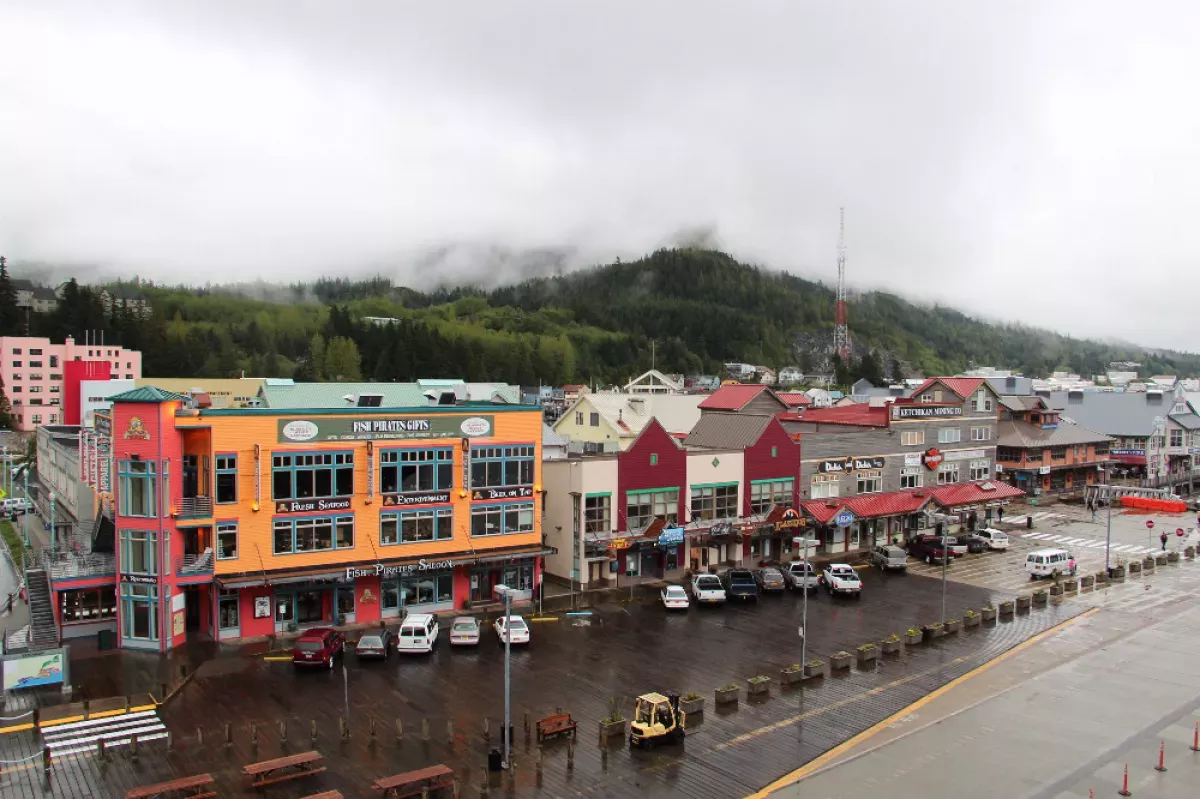Ketchikan, the southeasternmost major settlement in Alaska, serves as the borough seat of the Ketchikan Gateway Borough, situated on Revillagigedo Island. Its downtown area holds the distinction of being a designated National Historic Landmark District.
August 25, 1900
Ketchikan was officially incorporated on August 25, 1900, making it the oldest surviving incorporated city in Alaska.
1900
The community, recorded as "Ketchikan," was officially incorporated as a city in 1900 and has been included in every census since.
1905
A mission house, which would later become the Yates Memorial Hospital, was constructed in 1905.
1909
The mission house built in 1905 was transformed into the Yates Memorial Hospital in 1909.
June 25, 1913
Ketchikan experienced its highest recorded temperature of 96 degrees Fahrenheit on June 25, 1913.
January 23, 1916
The coldest temperature ever recorded in Ketchikan was -7 degrees Fahrenheit on January 23, 1916.
November 1917
November 1917 saw the highest monthly rainfall in Ketchikan's history, with 53.85 inches.
1948
Norman Ray "Doc" Walker, a Canadian-born pharmacist and a prominent figure in the Alaska Legislature, lost his reelection bid for the territorial Senate in 1948 after a disagreement with Territorial Governor Ernest Gruening, ending his 16-year tenure.
1949
The year 1949 was Ketchikan's wettest, receiving 202.55 inches of rainfall.
1954
Ketchikan Pulp Company's pulp mill commenced operations in Ward Cove in 1954.
January 1971
January 1971 holds the record for the most snowfall in Ketchikan, with 45.1 inches.
October 11, 1977
Ketchikan received its highest 24-hour rainfall on October 11, 1977, measuring 8.71 inches.
1990
The Tongass Timber Reform Act of 1990 was passed, ultimately leading to the closure of the Ketchikan Pulp Company pulp mill in 1997.
1995
A joint investigation by the EPA and FBI in 1995 uncovered that the Ketchikan Pulp Company had been dumping contaminated wastewater and sludge into the waters surrounding Ward Cove, resulting in their classification as "impaired" by the EPA. The company admitted guilt and accepted a $3 million fine.
1996
Louisiana-Pacific Corp. announced its decision to shut down the pulp mill in 1996 after the Clinton Administration declined to reinstate the original terms of their timber contract.
March 1997
Following the Clinton Administration's refusal to reinstate the initial terms of the Ketchikan Pulp Company's timber contract, Louisiana-Pacific Corp., the parent company, decided to close the pulp mill in March 1997, resulting in the loss of 514 direct year-round jobs and over 500 indirect jobs.
1997
The Ketchikan Pulp Company pulp mill in Ward Cove, which had been a significant part of Ketchikan's economy, closed down in 1997, following the 1990 Tongass Timber Reform Act's reduction in timber harvest targets.
March 1, 2004: Educational Exchange Program Established
An educational exchange program between Ketchikan and Kanayama was established in 1986, involving teacher and student exchanges for cultural immersion and language learning.
2009: Mythbusters Films in Ketchikan
The TV show Mythbusters filmed an episode in Ketchikan in 2009, testing if a ship made of ice and sawdust could float.
April 2010: Launch of the M/V Susitna
The Ketchikan Shipyard, owned and operated by Alaska Ship & Drydock, successfully launched the M/V Susitna, a prototype ferry craft for Alaska's Matanuska-Susitna Borough, in April 2010.
2010
According to the 2010 census, Ketchikan had a population of 8,050, comprising 3,259 households and 1,885 families.
January 2013
For the first time in Alaska's history, the convening of the 28th Alaska State Legislature in January 2013 saw no residents from Ketchikan or the surrounding areas serving as members.
September 20, 2014: Contract Awarded for New Alaska-Class Ferries
On September 20, 2014, the Ketchikan Shipyard was awarded a $101 million contract for the construction of two new Alaska-class day ferries for the Alaska Marine Highway.
May 2015: Delta Air Lines Begins Seasonal Service to Seattle
Delta Air Lines initiated seasonal service between Ketchikan International Airport and Seattle in May 2015.
2017
In 2017, the ACS estimated the median annual income for a household in Ketchikan to be $56,372, with an average of $70,490. The median family income was $68,438, with an average of $84,518. The per capita income was $30,474. Approximately 12.4% of the population lived below the poverty line, including 19.8% of those under 18 years old. English was the most spoken language at 90%, followed by Tagalog at 6%, Spanish at 1.8%, and Tsimshian at 0.7%.
2018
Ketchikan Harbour received over 1,073,000 visitors in 2018, with 40 different cruise ships making more than 500 stops.
2020
The 2020 census recorded Ketchikan's population at 8,192, up from 8,050 in 2010, making it the sixth-most populous city in Alaska.
2021
Dave Kiffer was elected as the mayor of Ketchikan in 2021.
Trending
1 month ago Newly Built Chinese Bridge Collapses Months After Opening, Raising Safety Concerns
1 month ago Texas A&M Aggies: CFB Playoff Rankings, Lane Kiffin's Defense, and Playoff Picture
2 months ago US Considers Strikes on Venezuela Over Drug Trafficking; Trump Denies Plans
7 months ago Russian Bridges Collapse: Train Derailment Claims Lives Near Ukraine, Leaving Seven Dead
6 months ago NYC Mayoral Race: Brad Lander Gains Momentum with Key Endorsements
6 months ago Brooklyn Center police shot man wielding chainsaw; BCA investigating incident.
Popular

Tucker Carlson is an American conservative political commentator known for...

Candace Owens is an American conservative political commentator and author...

XXXTentacion born Jahseh Dwayne Ricardo Onfroy was a controversial yet...

Ben Shapiro is a prominent American conservative political commentator media...

William Franklin Graham III commonly known as Franklin Graham is...

Bill Gates an American businessman and philanthropist revolutionized personal computing...


